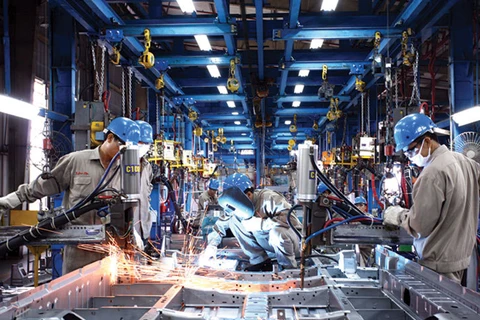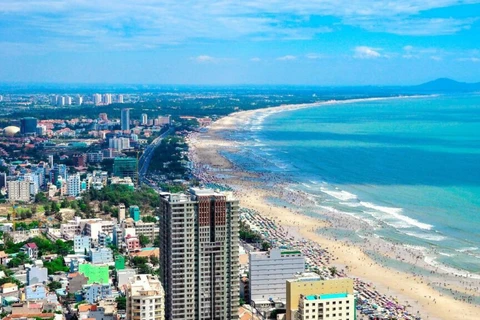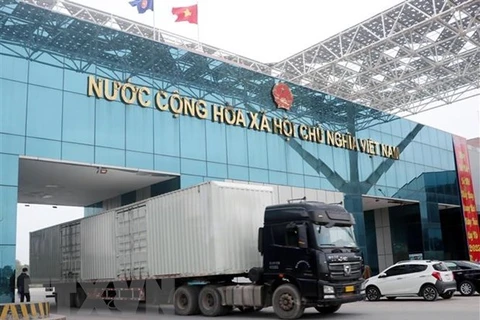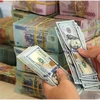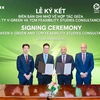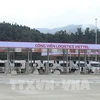Hanoi (VNA) – The Times of India daily has published an article titled “Vietnam’s Impressive March: The country is making a strong post-COVID recovery based on sound socio-economic fundamentals”.
According to the writing by journalist Rudroneel Ghosh, on a personal visit to Vietnam last month, he had the opportunity to visit one of the natural treasures of the world – Ha Long Bay.
However, the article isn’t about Ha Long Bay but draws readers’ attention to Ha Long city next to the bay. It noted that what struck Ghosh there was the rapid pace of construction evident in the city. Huge multi-storeyed complexes were being built across the city exemplifying robust economic activity. In fact, many of the complexes were designed in distinctive European styles with motifs, art pieces and names from the old continent.
“I could easily imagine these as tourist magnets serving as bed-and-breakfast inns, hotels and entertainment spots during peak tourist season.”
Importantly, this also told the journalist how well Vietnam’s economy has fared through the COVID-19 years and is now poised for accelerated growth. Thanks to Vietnam’s sagacious COVID management – which went from effective control in the initial phase to gradual opening up in line with evolving science – the country was able to mitigate the devastating impact the pandemic had in many nations.
 Hoi An is one of the first destinations in Vietnam to open to foreign visitors. (Photo: VietnamPlus)
Hoi An is one of the first destinations in Vietnam to open to foreign visitors. (Photo: VietnamPlus) The article cited an International Monetary Fund (IMF) country focus report in March 2021 as saying: “The pandemic hit the economy hard, but Vietnam has taken decisive steps to limit both the health and economic fallout. Swift introduction of containment measures, combined with aggressive contact tracing, targeted testing, and isolation of suspected COVID-19 cases, helped keep recorded infections and death rates notably low on a per capita basis. Successful containment, along with timely policy support, also helped limit the economic fallout and the size of the emergency response package. In 2020, the Vietnamese economy expanded by 2.9%, one of the highest growth rates in the world, backed by the early rebound of domestic activities and robust export performance, particularly higher-tech exports of electronics as people around the world worked from home.”
The report further added: “Vietnam entered the pandemic with solid economic fundamentals and policy buffers, although some structural challenges remain to be addressed. Since the advent of market-oriented “Doi Moi” reforms in 1986, Vietnam went from being one of the poorest countries in the world to one with lower middle-income status. Structural transformation from agriculture to a modern economy based on foreign direct investment-led manufacturing and the emphasis on “leaving no one behind” boosted living standards. Strong foreign investment and current account surpluses strengthened external resilience. The health of the banking system improved, with higher profitability, liquidity, and fewer non-performing loans than in the past, although weaknesses remained. And the country made considerable progress in consolidating public finances prior to COVID-19. The build-up of these fiscal, external, and financial buffers prior to the pandemic made Vietnam more resilient to the shock.”
 Ho Chi Minh City has been quickly recovering its economy after the COVID-19 pandemic. (Photo: VietnamPlus)
Ho Chi Minh City has been quickly recovering its economy after the COVID-19 pandemic. (Photo: VietnamPlus) On April 3, Vietnam’s Prime Minister Pham Minh Chinh, while chairing the Government’s online meeting with 63 localities nationwide and the Cabinet’s regular meeting, stated that the country had already achieved all its major targets for the first quarter of 2023. While the country’s first quarter GDP growth was estimated at 3.32%, its trade surplus reached 4.07 billion USD, doubling that of the same time last year.
In the tourism sector, Vietnam served nearly 2.7 million international visitors in the first three months of 2023, a whopping 29.7 times higher than that in the same period of 2022. This not only signifies that Vietnam is making a strong rebound in tourism, but also that the country’s tourism sector provides great money value for foreign tourists, the article read./.

